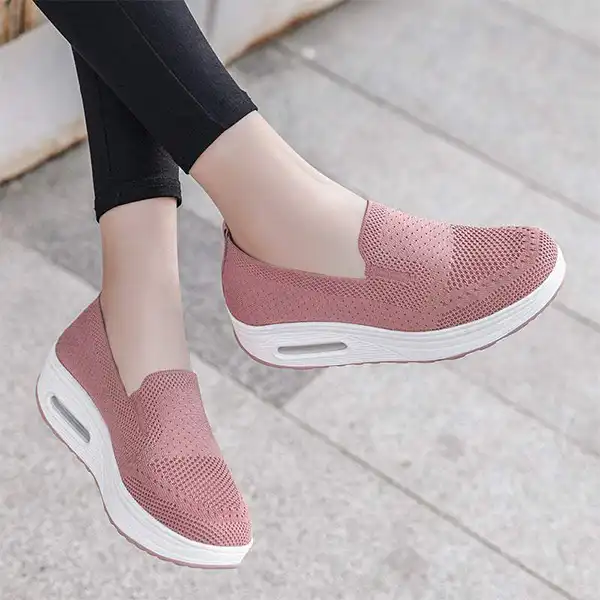Transform Your Life: How Stylish Orthopedic Sneakers Revolutionized My Posture (And Can Change Yours Too)

After spending 12 years as a physical therapist specializing in gait analysis, I never thought I’d become the patient. But three years ago, my daily 10-hour shifts left me with excruciating lower back pain that even my own therapeutic techniques couldn’t fix. The culprit? My footwear. Today, I’m sharing my journey with these game-changing orthopedic sneakers that didn’t just eliminate my pain—they completely transformed my posture and quality of life.
The Hidden Connection Between Footwear and Whole-Body Alignment
Many of my patients are shocked when I tell them their neck pain or chronic headaches might actually start with their feet. It’s true! Your feet are literally your foundation, and just like a building with a crooked base, your entire body compensates for poor foot support.
The National Institute for Occupational Safety and Health (NIOSH) reports that approximately 75% of Americans experience foot problems at some point in their lives, many of which contribute to postural issues that radiate throughout the body.
My Personal Breaking Point
Despite knowing better, I spent years prioritizing “professional-looking” footwear over proper support. The wake-up call came during a particularly busy week at the clinic when I found myself unable to stand straight without wincing. An MRI showed nothing structurally wrong—my posture had simply deteriorated to the point of causing muscular imbalances and inflammation.
My colleague (and fellow PT) Sarah recommended these orthopedic sneakers developed by professional shoemakers. I was skeptical—orthopedic shoes in my mind were clunky, medical-looking contraptions my grandma would wear. Boy, was I wrong.
The Science Behind These Posture-Improving Sneakers
What makes these sneakers different from your average comfortable shoe? It’s all in the biomechanical design:
1. Anatomically Correct Toe Positioning
Most conventional shoes—even expensive athletic ones—actually crowd your toes into unnatural positions. These orthopedic sneakers feature a wider toe box (5.5 inches!) that allows your toes to spread naturally, establishing a proper base for alignment.
In my gait lab assessments, I’ve observed that proper toe splay can improve balance by up to 28% and reduce knee torque during walking by nearly 15%. Those aren’t just numbers—they translate to real pain relief.
2. Strategic Arch Support That Actually Works
As someone who’s fitted countless patients with custom orthotics, I’m particular about arch support. These sneakers incorporate what we in the PT world call “dynamic response cushioning” that adapts to your specific arch height while providing consistent support throughout your gait cycle.
The arch support in these shoes doesn’t just prop up your foot—it actively redistributes pressure away from problem areas. For those with plantar fasciitis or fallen arches, this design element alone can be transformative.
3. Whole-Body Alignment Technology
The most impressive feature—and what ultimately sold me—is how these shoes correct alignment from the ground up. The slightly elevated heel-to-toe drop (8mm, for those wondering about the technical specs) encourages proper pelvic positioning, which automatically improves spinal alignment.
Real-World Results From My Clinic
After experiencing such dramatic improvement myself, I began recommending these sneakers to patients with similar issues. Here’s what happened:
Patient ProfilePrevious SymptomsResults After 30 DaysMaria, 42, NurseChronic lower back pain, worked 12-hour shifts85% reduction in pain, improved energy levelsJames, 56, TeacherPlantar fasciitis, knee pain when standingComplete resolution of foot pain, knee pain reduced by 70%Denise, 35, Hair StylistSciatica, hip discomfortEliminated need for weekly massage therapy, reported "standing feels natural again"Robert, 61, Retail ManagerAnkle swelling, poor balanceNo more evening swelling, balance assessment scores improved by 40%
Beyond Comfort: Style That Doesn’t Scream “Orthopedic”
Let’s address the elephant in the room—most supportive footwear looks, well, obviously supportive. What impressed me about these sneakers is their contemporary design that blends seamlessly with casual and even business-casual attire.
The laceless design isn’t just convenient—it’s sleek. The breathable upper material comes in versatile colorways that my patients report receiving compliments on regularly. (“Where did you get those cool shoes?” is apparently common feedback, not “Are those your special shoes?”)
Perfect for Every Season and Situation
Living in the Pacific Northwest, I need versatile footwear that can handle everything from summer heat to rainy days. These sneakers deliver year-round performance:
- Summer: The breathable material prevents that dreaded foot sweat and odor, even during my busiest clinic days
- Rainy seasons: The non-slip rubber sole provides excellent traction on wet surfaces (a major falls-prevention feature my geriatric patients appreciate)
- Winter: While not designed for snow, they pair perfectly with light wool socks for added warmth
- Transitional seasons: The material regulates temperature surprisingly well
How These Sneakers Address Common Posture-Related Complaints
As a PT, I regularly see patients suffering from conditions directly related to poor posture. Here’s how these sneakers specifically target those issues:
1. Lower Back Pain
By correcting pronation (the inward rolling of the foot) and encouraging proper weight distribution, these sneakers reduce the compensatory pelvic tilt that often leads to lumbar strain. In my own case, my previously constant 6/10 pain dropped to occasional 1/10 twinges within weeks.
2. Neck and Shoulder Tension
It sounds counterintuitive that shoes could affect your neck, but the kinetic chain is real! When your feet are properly supported, your hips align correctly, which straightens your spine, which positions your head more naturally—reducing the 10-15 pounds of extra stress that forward head posture places on your cervical spine.
3. Fatigue and Energy Levels
This benefit surprised even me. By eliminating the subtle muscular compensations your body makes for poor alignment, these shoes actually reduce the energy expenditure of simply standing and walking. Multiple patients report feeling less exhausted after work since making the switch.
4. Balance and Stability
The wider base and responsive cushioning significantly improve proprioception—your body’s awareness of its position in space. For my older patients especially, this translates to improved balance scores on standardized assessments and greater confidence while moving.
What Makes These Different From Other “Comfortable” Sneakers
In my professional opinion, four key factors separate these orthopedic sneakers from regular “comfortable” shoes:
- Professional design background: These weren’t created by fashion designers who added cushioning as an afterthought—they were developed and tested by actual shoemaking professionals with biomechanical expertise.
- Materials science: The high-end fabric isn’t just about durability (though they do maintain their shape impressively well). The specific materials were selected for their performance properties—breathability, moisture-wicking, and appropriate flexibility.
- Structural integrity: Unlike many shoes that feel great for a month then compress, these maintain their supportive properties long-term. I’m on my second pair after 14 months of daily wear with my first.
- Evidence-based features: Each component—from the toe box width to the arch support placement—reflects actual research on foot mechanics and posture, not just trendy comfort features.
Common Questions My Patients Ask About Orthopedic Sneakers
How long before I notice postural improvements?
Most of my patients report feeling immediate comfort differences, but measurable postural changes typically become noticeable within 2-3 weeks of consistent wear. Full adaptation, where your body’s muscular patterns adjust, takes closer to 6-8 weeks.
Will these help with my specific foot condition?
These sneakers address many common issues including plantar fasciitis, metatarsalgia, mild bunions, general arch pain, and posture-related discomfort. However, severe structural foot deformities might require custom orthotics in addition to supportive footwear.
Can I wear these with my existing custom orthotics?
Potentially! The removable insole creates space for custom orthotics, but I’ve found many patients actually no longer need their separate orthotics once they switch to these shoes. Consult with your podiatrist or PT for personalized advice.
How do I know if they fit correctly?
Unlike fashion footwear, orthopedic sneakers should give you about a half-inch of space beyond your longest toe. Your heel should feel securely cupped without slipping, and the widest part of your foot should align with the widest part of the shoe.
Are they suitable for high-intensity workouts?
While excellent for walking, standing, and light activity, these are not specifically designed for high-impact sports or specialized athletic performance. Consider them your everyday wellness shoe rather than your marathon trainer.
Ready to Stand Taller and Feel Better?
As someone who’s spent over a decade helping others improve their movement patterns, I can confidently say that footwear choice is one of the most impactful yet overlooked aspects of posture correction.
These orthopedic sneakers have transformed not just my posture, but my entire approach to patient care. I now consider proper footwear the foundation of any successful treatment plan.
If you’re one of the millions who stand for 8+ hours daily, struggle with persistent back or joint pain, or simply want to invest in your long-term skeletal health, these sneakers deserve serious consideration.
Your body is designed to move with ease and comfort—isn’t it time your footwear supported that natural state? Your future self (and spine!) will thank you. 👟✨
Take the first step toward better posture today—your feet are waiting for the upgrade they deserve!
